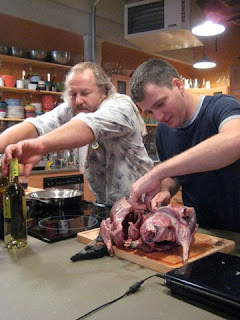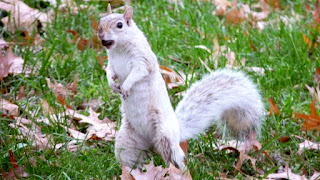 |
Hounds work to pick up the scent of a bear that had crossed a Forest
Service road in Tehama County, California.
© Holly A. Heyser 2012 |
By Holly A. HeyserThree years ago, I had a pretty low opinion of hunting bears with hounds. Being a relatively new hunter, I wasn't yet aware that even in the hunting community, there was disdain for houndsmen. I just didn't like the idea of a hound hunt. I preferred - then and now - ambush over chase.
It wasn't just that aesthetic, though; the big stopper for me was the idea of shooting a helpless and frightened treed bear. I always put myself in the heads of the animals I am about to shoot, or have just shot, and the treed bear's perspective made me cringe.
So, how was it that I found myself shooting a 225-pound black bear out of a tree this Sunday? It started with the Humane Society of the United States' campaign against bear hunting in California.
 |
A bear track on a Forest Service
road.
© Holly A. Heyser 2012 |
In 2010, California's black bear population was continuing to grow, and there was an effort to increase the "quota" - the total number of bears that can be killed by hunters each year. That, of course, caught HSUS' attention, and it launched one of its emotionally laden, fact-deficient campaigns.
One word in particular set me off: "trophy." The HSUS California lobbyist was being quoted in newspapers all over the state referring to "the trophy hunting of bears."
Hmm. Most hunters I know would love to get a "trophy" animal of any species, but most are also just happy to be successful on a hunt - smaller animals are fine.
This was nothing less than the organization's usual strategy for picking low-hanging fruit: Public support for meat hunting is very high - 85 percent - while public support for trophy hunting is very low - 28 percent (source: Responsive Management, 2006). Most non-hunters I've met interpret "trophy hunting" as "not eating the meat." Say the word "trophy" and you can count on fanning hostile sentiment among non-hunters. (
Here's what I wrote on the topic in my blog that year.)
There was another component to the Department of Fish & Game's proposal: allowing houndsmen to use GPS collars on their dogs, making them easier to track down. I ignored this, because I knew nothing about it and really didn't much care for the whole hound thing.
Neither proposal passed that year. One year later, DFG tried again to raise the quota, but dropped the GPS tracking collar issue. This effort, which I blogged about
here, also failed.
Then this year, there was a big public relations disaster: The president of our Fish and Game Commission, Dan Richards, hunted a lion with hounds in Idaho and sent a photo to a weekly hook-and-bullet newspaper, Western Outdoor News. What he did was legal in Idaho, but Californians had banned all lion hunting here. HSUS fomented outrage, and tried to get Richards booted from the commission. (
Here was my take on that.)
Closed-door politics defeated that effort, but the HSUS still wanted to demonstrate its power, so it decided to go after hunting with hounds, partnering with Southern California state Sen. Ted Lieu to introduce a bill that would ban hunting bears and bobcats (but not pigs) with hounds.
 |
Two Plott hounds ride atop the box on the back of a pickup,
chained to the box for safety. The driver cruises Forest Service
roads slowly in hopes that the dogs will detect the scent of a
recent bear crossing - called a "strike," which the dogs will
signal with their signature bark.
© Holly A. Heyser 2012 |
By this time, I had already begun trying to learn more about hound hunting from friends - people I liked and respected - who were familiar with it. Before I started hunting, my view of hunters was that they had to be sick to get off on killing. But watching my boyfriend learn to hunt, then deciding to take it up myself, showed me how wrong I was. Could I also be wrong about hunting bears with hounds?
After remaining silent on hunting with hounds in the previous debates, I now
leapt to the defense of houndsmen, because it was becoming clear they were being caricatured - another typical HSUS tactic - as lazy rednecks who kick back while dogs do all the work.
HSUS also really hyped the "terrified, treed bear" image, and I'd heard so many houndsmen reject that depiction, which had been the core of my concern, that I began to doubt my assumptions. More on that later.
I took a long hard look at how I hunted, or to be more exact, the nature of the deaths I caused. I came up with three kinds:
* Some were my own Holy Grail: instant deaths that they didn't see coming. One pig I have shot died instantly, and probably half of the birds I've shot did as well (some of which didn't see it coming, some of which did moments before the shot).
* Some were close to my ideal: quick deaths. They didn't die instantly, but because I had hit lungs, they had bled out and died within a minute. Three big-game animals I had shot went this way (none of them saw it coming), and maybe a third of the birds I've shot did as well (again, some saw it coming, but others didn't).
* Some were cringe-worthy deaths: poor shots that merely crippled, leading to suffering that would last until I finished the job. One pig I shot went this way (found him and finished him off within five minutes) and all the remaining birds did as well (most finished off quickly, but undoubtedly some got away - it's inevitable). I have chased lots of birds that were trying like hell to get away from me.
I despise the third category, yet I accept that it is an unavoidable facet of hunting: We cannot shoot perfectly all the time, which means invariably I will have to chase an animal before killing it. If I could accept that, why could I not accept shooting a treed bear? I decided I would go on such a hunt to gain some firsthand knowledge.
 |
A houndsman waits with me on the road while the rest of our hunting party follows
dogs working a cold bear trail in steep
terrain.
© Holly A. Heyser 2012 |
The hunt could be an entire story itself, but I'll just hit the key facts here: We hunted 10 hours the first day, slowly cruising Forest Service roads with hounds riding atop the vehicles in hopes that they would catch the scent of a bear that had crossed the road, or that we would see tracks of bears crossing the road. No fresh tracks, no "strikes" - which is what they call the hounds' reaction to a fresh scent.
We had hunted that way for maybe five hours on the second day when we stopped to check out some tracks that seemed reasonably fresh. The scent was so cold that no one was sure the dogs would be able to follow it, but they did, and within about an hour we heard the barking that indicated they had treed the bear.
As we set out toward the cacophony, my empathy reaction kicked in: I imagined what that bear was experiencing at that moment. I wondered if I could go through with it. Then I remembered why I was there: I had already decided to kill a bear on a hunt with houndsmen. I wanted and needed meat from a big-game animal in my freezer. And I needed to know - really know - what it meant to kill a treed bear.
When we got there, it went down fast. From one position, I couldn't get a shot. I shifted to a better position, and the bear started coming down the tree. Here's the thing: Bears will stay in trees over barking dogs for hours, unconcerned about creatures that can't climb up to get them. Humans, on the other hand, are a real threat, and bears are willing to risk contact with the dogs to get away from us.
As she started making her way down fast, I put the crosshairs behind her shoulder and pulled the trigger. She fell dead.
Did I hate myself for killing her that way? No. I had the same reaction I always do: I was grateful I had made a good shot, in this case doubly so because a wounded bear is dangerous, whereas wounded ducks, pheasants and doves aren't. I was grateful that I would be bringing home a LOT of meat. And I was mindful that I had ended her life, which is always - ALWAYS - a serious event, regardless of whether the animal sees it coming.
 |
| This is me with the bear I killed Sunday. |
Would I do this again? Yes. While the road-cruising was tedious, I admired the dogs' skill and the houndsmen's fitness, watching them clamber up and down hills that had me out of breath in 10 seconds. When I last saw them on Monday, they were preparing to head out to an area that would require brutal hiking - no road cruising - something they'd tried to spare me on my first bear hunt.
Also, I like bear meat, and this is an effective way to get it.
Sadly, though, I will not be doing this again, because the California Legislature passed that bill. Hunting bears with hounds will be illegal next year, and I have tagged out for this year's season.
We've lost something here in California, and I wonder how many hunters - laboring under the same knee-jerk reaction I'd had - don't even realize it. I'm just glad I took the time to get to know something I didn't understand before it was too late.
© Holly A. Heyser 2012
 :.
:.









